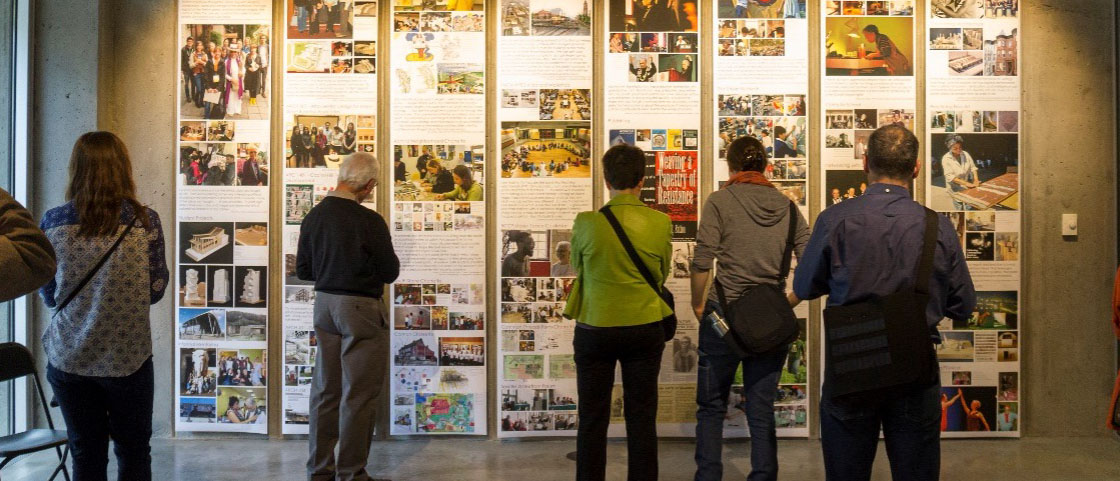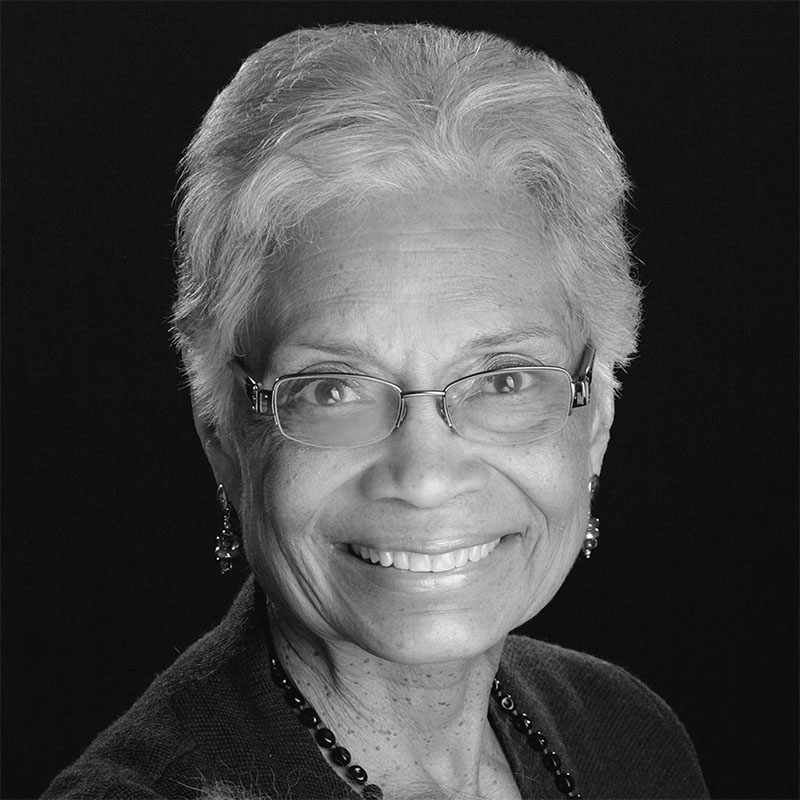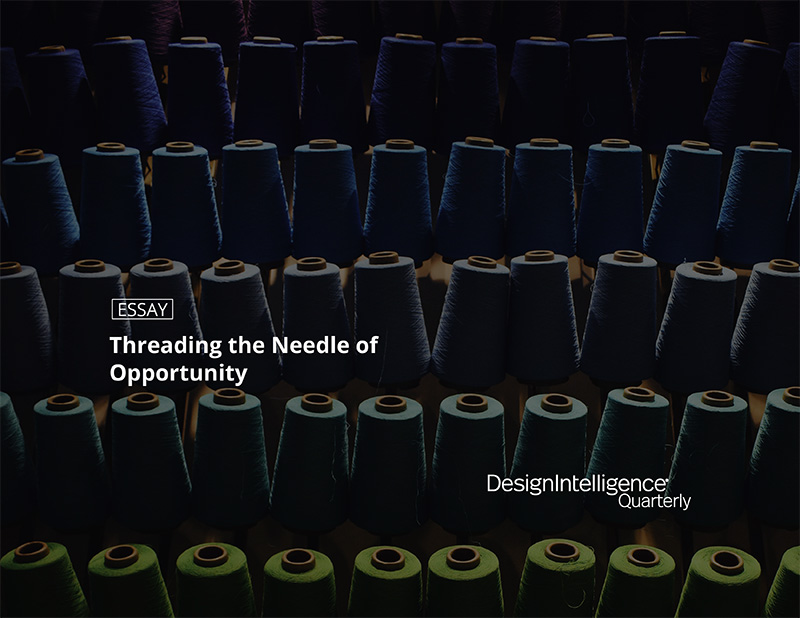Threading the Needle of Opportunity
by Dr. Sharon Egretta Sutton
FAIA
September 20, 2021
In this eight-decade personal reflection, Dr. Sharon Egretta Sutton, FAIA, recounts the interplay of obstacles and opportunities she experienced — and offers advice for professional inclusion
Beginning my ninth decade upon Earth in the aftermath of the country’s racial reckoning has brought on no small amount of introspection. Having beat the odds to achieve distinction in my field, I feel obligated to take stock and offer meaningful advice to those who follow me in their journey. In hindsight, my career trajectory seems direct, punctuated every decade or so by the nation’s swerve to the political left or right, but in real time, I felt as if I was threading a needle through layers of a thick, knotted fabric. You see, I began my journey right after my dad — in his singsong, hillbilly dialect — flat-out contradicted my teachers, my relatives and neighbors, the minister at my church and even my schoolteacher mother, defiantly proclaiming:
“Why, this girl can do anything she wants to do.”
Emboldened by his I-double-dare-you courage, I inched forward. Since then, I have advanced decade by decade, threading a needle through the almost serendipitous openings that appeared between constraints and opportunities. I share these reflections to help you do the same.

Attendees viewing a display at the opening reception of the Sharon Egretta Sutton Retrospective, University of Washington Gould Gallery, 2016. Author Image
The first opening appeared in 1959 as I was finishing high school in Cincinnati, Ohio, known as “the gateway to the South,” in part because of the city’s embrace of southern Jim Crow laws that mandated racial segregation. I had set my heart upon a career in classical music but finding someone to provide the requisite instruction proved daunting. So did ushering at Cincinnati Symphony Orchestra concerts with my white classmates when the manager called the police to escort me from the building. Nor could I become a member of Cincinnati’s racially restricted American Federation of Musicians Local 1. My only hope for achieving my dream was to head north. After I received a full-tuition scholarship from New York City’s Manhattan School of Music, my dad cobbled together a tiny monthly allowance for living expenses, and I prepared to pass through this first opening. I packed my belongings into a steamer trunk and moved out of my parents’ home just as urban renewal was about to destroy the exceedingly pleasant — though segregated — neighborhood where I had grown up.
As it turned out, the opening was a lot smaller than I had anticipated due to New York’s unique brand of Jim Crow-like practices that restricted my opportunities to rent housing with the acoustic privacy that would accommodate practicing the French horn. Being denied New York City apartments and simultaneously watching the destruction of homes in my childhood neighborhood initiated me into the brutality of housing discrimination. Searching for a way forward, I realized that I could use the enemy — urban renewal — to my benefit. I obtained the funding urban renewal offered to rehabilitate a rat-infested rooming house on Manhattan’s Upper West Side into a Class-A, rent-controlled apartment building. By 1965, six years after leaving Cincinnati, I had joined New York’s American Federation of Musicians Local 802, was touring the unsegregated part of the country and Canada with ballet companies and had received a Certificate of Occupancy on the rooming housing I converted into affordable housing. My career was moving forward.
The second opening appeared in 1968, a year of racial rebellions, Vietnam War casualties, student insurrections, assassinations, Black Power, feminism and cultural expressiveness. Earning front-page attention in the New York Times was a springtime student insurrection at Columbia University so virulent that classes did not resume until fall. Compared with the social dramas of those times, my job in the orchestra pit of the hit Broadway musical “Man of La Mancha” seemed mundane. Even the interior design classes I had begun taking at Parsons School of Design did little to alleviate the tedium of performing the same music eight times a week (by then, I would have played some 1,500 shows).

Presenting at the opening reception of the Sharon Egretta Sutton Retrospective, University of Washington Gould Gallery, 2016. Author image.
Paralleling my state of disaffection were negotiations at Columbia related to the student insurgency. When resolution of one of the demands led the School of Architecture to begin recruiting African American and Puerto Rican students, I received a call to come for an interview. I hauled my 30-inch by 40-inch portfolio of Parsons projects into a meeting with the architecture program chair and received an on-the-spot admissions offer. I had intended to continue working in the theater, but my Columbia teachers admonished that architecture school was a full-time commitment, so I quit my union job and accepted a second full-tuition scholarship. Once again, I had discovered an opening — this one created by demands for justice from privileged white male students.
After spending 20 hours a week in the darkness of an orchestra pit, I moved forward to spend night and day in the brightness of Avery Hall’s Italian Renaissance design studios. There, I found another world, where I imagined new spaces for learning and living, studied printmaking in Florence, Italy, became licensed to practice architecture and discovered a love of teaching at Pratt Institute. Still, some things from my past remained and guided my future, especially the discipline I had acquired to practice, practice, practice. My career had shifted, but it was advancing, powered by a calling to do what I wanted to do.
In 1984, the third opening in the irregular fabric of constraints and opportunities appeared as a result of the swerve to the right that Reagan’s landslide reelection provoked. In race-neutral language, Reagan fueled racial enmity, condemning welfare queens, intensifying the war on drugs and publicizing the crack epidemic as the root of all evil — exhortations that incited those who were sick and tired of the civil rights movement. In that inflammatory year, the University of Michigan recruited me as an affirmative action hire. I was terrified of moving out of New York City to the Midwest, where the Ku Klux Klan had the reputation of being the strongest outside the South, but I found an invitation from the renowned “Harvard of the Midwest” irresistible.
So, I moved from the cultural richness of midtown Manhattan to the only place where I could afford the real estate: a rural town outside Ann Arbor with an all-white population of Christian families, each having the obligatory two-and-a-half children. Then, one wintery day in 1987, as I worked in my studio there (questioning my sanity in making the move), I heard on the university radio station faculty and students testifying live for four hours before the state legislature, describing incidents of racial enmity on campus and in town. Bingo! An opening appeared between racism and an opportunity to counter it.
After the legislature threatened to withhold funding until the campus became significantly more welcoming to persons of color, a new university president (the former one having fled during the political fray) put forward an aggressive plan called the Michigan Mandate, intended to bolster the dismally low percentages of African American, Asian and Hispanic faculty and students. I joined several interdisciplinary groups of activist faculty members (mostly from public health, social work, urban planning and women’s studies) who urged central administration to look beyond numerical increases and adopt transformative approaches to teaching and learning and dormitory life. Propelled by the Michigan Mandate, university administrators funded several of our proposals, as did the William and Flora Hewlett Foundation, among others.
Having a platform for doing innovative work at a great university opened unimagined doors. With funding from the National Endowment for the Arts and the W.K. Kellogg Foundation, I inaugurated a national program in urban design for youth and used its award-winning outcomes to populate a dossier that guaranteed my promotion to full professor, elevation to fellowship, induction into the Michigan Women’s Hall of Fame and election as president of the National Architectural Accreditation Board. The door it did not open was to a leadership position in the architecture program. In fact, the dean took extreme measures to prevent me from becoming chair, his fierce opposition pushing me toward the fourth opening.
Blocked from advancement in my discipline at the University of Michigan, I moved cross-country to Seattle, where I could practice the theories of civic engagement that lay at the heart of my academic scholarship. I vigorously partook in the city’s urban design debates as a member of the design commission and chair of a design review board. Under my purview were such projects as Rem Koolhaas’s Seattle Central Library, Peter Bohlin’s Seattle City Hall, a redesign of the Olmsted Brothers’ Cal Anderson Park and the Bullitt Center, the nation’s first building to achieve net-zero energy use. But my most satisfying civic practice occurred during my later years, when I dug into my early rooming house schooling in how to turn discriminatory policies inside out. In this case, I reverse engineered my knowledge of city hall’s inner workings to tutor union workers and low-income residents in resisting unwanted development in their communities, amplifying their voices with my own to achieve small wins. Though David never overcame Goliath, the struggle was empowering.
Simultaneous with being a practicing citizen-architect, I was a professor at the University of Washington, where I had negotiated another affirmative action position. There, I reinvented an existing applied research center and used it to stage community design charrettes and design-build projects throughout the Puget Sound region, generating opportunities for public scholarship that reinforced my civic engagement. Then, unsolicited Ford Foundation funding secured my successful passage through another opening, allowing me to lead a 21-person research team in uncovering the incredibly creative work that low-income youth of color do in community-based organizations across the country. As George Bush plunged the nation into the Iraq War, their resistance to marginalization lifted my spirits.
I spent 17 1/2 years in Seattle stitching together scholarship and practice with social activism. Though another dean surfaced to prevent me from becoming chair of the architecture department, I continued moving forward, receiving among other recognitions the American Institute of Architect’s Whitney M. Young Jr. Award and a medal of honor from that organization’s Seattle chapter. Still, over time, I became downright weary of being the only African American on a college faculty that numbered more than 80, inescapable whiteness pushing me toward the next opening: moving back to the nation’s greatest, most colorful city to celebrate Hillary Clinton as the first woman president of the United States. As had happened in earlier decades, a tragedy (in this case Donald Trump’s triumph) launched yet another opportunity.
Waking up each morning to some unspeakable incursion into democracy, I began to obsess about that old Ford Foundation study that had lifted my spirits during the Bush years. After many false starts, and with the encouragement of a dean at Parsons School of Design who had laid out the red carpet for my homecoming, I decided to use the data to show how idealistic youth of color push the nation toward its democratic ideals while remaking their disinvested neighborhoods with their hands, minds and hearts. I steered a manuscript through to publication, this latest opening littered with debris from George Floyd’s murder and the worldwide protests against U.S. racism that it unleashed, a global pandemic that secluded me in my apartment for 80 days, an attack upon the U.S. capital to prevent Joe Biden’s reclamation of the White House, unfathomable fires and floods resulting from an ignored climate crisis and, at last, the declaration of Juneteenth as a national holiday. Though it is too soon to see up ahead, I know that another opportunity awaits my courage to seize it.

So, you see, my career trajectory has been anything but direct. Like the nation’s journey toward democracy, it took many twists and turns as I encountered — and reencountered — constraints and opportunities. At each moment in America’s halting progress toward its founding declaration to embrace all and not just some, a door would open or slam shut, sometimes due to societal or institutional forces, sometimes due to a single individual. But I always found just enough space to continue my trajectory toward democracy’s promise. Despite constraints, opportunities invariably emerged and summoned my courage in seizing them.
As you move forward along your own path, I pass that courage forward to you. Recalling the wisdom my dad offered to me when he was in his ninth decade, I intone his hillbilly dialect to say,
“Only strong people get old; the weak ones quit when the going gets rough.”
Today’s world is indeed rough — much rougher than when I started out. In your journey, you will need to thread a needle through layers of fabric that multiple crises have ripped apart, most notably economic inequality, extreme climate and hate-filled intolerance. But I guarantee you that openings will appear between the formidable constraints and unimagined opportunities that await you. If you have the courage to move forward, you will succeed. Just be defiant and flat-out proclaim: “Why, I can do anything I want to do.”
Dr. Sharon Egretta Sutton, FAIA, is distinguished visiting professor of architecture at Parsons School of Design and author of a forthcoming book, A Pedagogy of Hope: Pursuing Democracy’s Promise through Place-Based Activism. Her early outspoken advocacy for using participatory research and design to help disenfranchised communities change their circumstances position her as a pioneer in moving the field toward inclusion.


